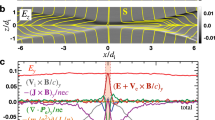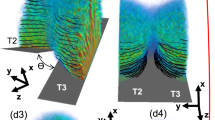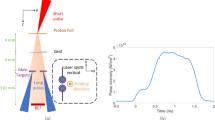Abstract
Magnetic reconnection changes the topology of magnetic field lines to a lower-energy state. This process can liberate stored magnetic field energy and accelerate particles during unsteady, explosive events. This is one of the most important processes in astrophysical, space and laboratory plasmas. The abrupt onset and cessation has been a long-standing puzzle. We show the first three-dimensional (3D) laboratory example of the onset and stagnation of magnetic reconnection between magnetized and parallel current channels (flux ropes) driven by magnetohydrodynamic (MHD) attraction and a 3D plasma-current-driven instability. Antiparallel magnetic field lines carried by these colliding flux ropes annihilate and drive an electric field. The inflow soon exceeds a threshold for the formation of a reconnection current layer. Magnetic flux and pressure pile up just outside this layer, and eventually become large enough to support MHD back-reaction forces that stall the inflow and stagnate the reconnection process.
This is a preview of subscription content, access via your institution
Access options
Subscribe to this journal
Receive 12 print issues and online access
$209.00 per year
only $17.42 per issue
Buy this article
- Purchase on Springer Link
- Instant access to full article PDF
Prices may be subject to local taxes which are calculated during checkout

 data for Bz0=100 gauss in the x–y cutplane at z=48 cm.
data for Bz0=100 gauss in the x–y cutplane at z=48 cm.




Similar content being viewed by others
References
Biskamp, D. Magnetic Reconnection in Plasmas (Cambridge Univ. Press, 2000).
Priest, E. R. & Forbes, T. Magnetic Reconnection (Cambridge Univ. Press, 2000).
Mozer, F. S., Phan, T. D. & Bale, S. D. The complex structure of the reconnecting magnetopause. Phys. Plasmas 10, 2480–2485 (2003).
Kulsrud, R. M. Plasma Physics for Astrophysics (Princeton Univ. Press, 2005).
Taylor, J. B. Relaxation and magnetic reconnection in plasmas. Rev. Mod. Phys. 58, 741–763 (1986).
Yamada, M. Review of controlled laboratory experiments on physics of magnetic reconnection. J. Geophys. Res. 104, 14529–14541 (1999).
Parker, E. N. Sweet’s mechanism for merging magnetic fields in conducting fluids. J. Geophys. Res. 62, 509–520 (1957).
Sweet, P. A. The Neutral Point Theory of Solar Flares (Cambridge Univ. Press, 1958).
Xiao, C. J. et al. In situ evidence for the structure of a magnetic null in a 3D reconnection event in the Earth’s magnetotail. Nature Phys. 2, 478–483 (2006).
Gekelman, W. & Pfister, H. Experimental observations of the tearing of an electron current sheet. Phys. Fluids 31, 2017–2025 (1988).
Linton, M. G. Dynamics of magnetic flux tubes in space and laboratory plasmas. Phys. Plasmas 13, 058301 (2006).
Furno, I. et al. Current-driven rotating-kink mode in a plasma column with a non-line-tied free end. Phys. Rev. Lett. 97, 015002–015004 (2006).
Sun, X., Intrator, T.P., Dorf, L., Furno, I. & Lapenta, G. Transition of MHD kink stability properties between line-tied and non line tied boundary conditions. Phys. Rev. Lett. 100, 205004 (2008).
Haerendel, G., Paschmann, G., Sckopke, N. & Rosenbauer, H. The frontside boundary layer of the magnetosphere and the problem of reconnection. J. Geophys. Res. 83, 3195–3216 (1978).
Roederer, J. G. Global problems in magnetospheric plasma physics and prospects for their solution. Space Sci. Rev. 21, 23–71 (1977).
Phan, T. D. et al. A magnetic reconnection X-line extending more than 309 Earth radii in the solar wind. Nature 439, 175–178 (2006).
Egedal, J. et al. Laboratory observations of spontaneous magnetic reconnection. Phys. Rev. Lett. 98, 015003 (2007).
Baum, P. J. Plasma instability at an X-type magnetic neutral point. Phys. Fluids 16, 1501–1504 (1973).
Frank, A. G. Magnetic reconnection and current sheet formation in 3D magnetic configurations. Plasma Phys. Control Fusion 41, A687–A697 (1999).
Wan, W. & Lapenta, G. Micro–macro coupling in plasma self-organization processes during island coalescence. Phys. Rev. Lett. 100 035004 (2008).
Biskamp, D. & Welter, H. Coalescence of magnetic islands. Phys. Rev. Lett. 44, 1069–1071 (1980).
Knoll, D. A. & Chacon, L. Coalescence of magnetic islands in the low-resistivity, Hall-MHD regime. Phys. Rev. Lett. 96, 135001–135004 (2006).
Furno, I. et al. Reconnection scaling experiment: A new device for three-dimensional magnetic reconnection studies. Rev. Sci. Instrum. 74, 2324–2331 (2003).
Intrator, T. et al. Long lifetime current driven rotating kink modes in a non line-tied plasma column with a free end. J. Geophys. Res. 112, A05S90 (2007).
Hemsing, E. W., Furno, I. & Intrator, T. P. Fast camera images of flux ropes during plasma relaxation. IEEE Trans. Plasma Sci. 33, 448–449 (2005).
Intrator, T. P., Sun, X., Dorf, L., Furno, I. & Lapenta, G. A three dimensional probe positioner. Rev. Sci. Instrum. 79, 10F129 (2008).
Ryutov, D. D., Furno, I., Intrator, T. P., Abbate, S. & Madziwa-Nussinov, T. Phenomenological theory of the kink instability in a slender plasma column. Phys. Plasmas 13, 032105 (2006).
Lapenta, G., Furno, I., Intrator, T. & Delzanno, G. L. Kink instability of flux ropes anchored at one end and free at the other. J. Geophys. Res. 111, A12S06 (2006).
Ji, H. et al. New insights into dissipation in the electron layer during magnetic reconnection. Geophys. Res. Lett. 35, L13106 (2008).
Birn, J. & Priest, E. R. Reconnection of Magnetic Fields (Cambridge Univ. Press, 2007).
Hesse, M., Kuznetsova, M. & Birn, J. The role of electron heat flux in guide-field magnetic reconnection. Phys. Plasmas 11, 5387–5397 (2004).
Anderson, C. & Priest, E. R. Time dependent magnetic annhilation at a stagnation point. J. Geophys. Res. 98, 19395–19407 (1993).
Dorelli, J. C. & Birn, J. Whistler mediated magnetic reconnection in large systems: Magnetic flux pileup and the formation of thin current sheets. J. Geophys. Res. 108, 1133 (2003).
Zweibel, E. G. & Rhoads, J. E. Magnetic merging in colliding flux tubes. Astrophys. J. 440, 407–414 (1995).
Simakov, A. N., Chacon, L. & Knoll, D. A. Semi analytical model for flux pileup limited, dynamically reconnecting systems in resistive magnetohydrodynamics. Phys. Plasmas 13, 082103 (2006).
Brackbill, J. U. FLIP MHD: A particle-in-cell method for magnetohydrodynamics. J. Comput. Phys. 96, 163–192 (1991).
Milano, L. J., Dmitruk, P., Mandrini, C. H. & Gomez, D. O. Quasi separatrix layers in a reduced magnetohydrodynamic model of a coronal loop. Astrophys. J. 521, 889–897 (1999).
Rogers, B. N., Denton, R. E., Drake, J. F. & Shay, M. A. Role of dispersive waves in collisionless magnetic reconnection. Phys. Rev. Lett. 87, 195004 (2001).
Wang, Y., Kulsrud, R. & Ji, H. An analytic study of the perpendicularly propagating electromagnetic drift instabilities in the magnetic reconnection experiment. Phys. Plasmas 15, 122105 (2008).
Mozer, F. S., Angelopoulos, V., Bonnell, J., Glassmeier, K. H. & McFadden, J. P. THEMIS observations of modified Hall fields in asymmetric magnetic field reconnection. Geophys. Res. Lett. 35, L17S04 (2008).
Cramer, N, F. & Donnelly, I. J. Surface and discrete Alfvén waves in a current carrying plasma. Plasma Phys. Control. Fusion 26, 1285–1298 (1984).
Acknowledgements
This work was supported by the Los Alamos Laboratory Directed Research and Development program under LANS Contract No. DE-AC52-06NA25396, and the Physics Frontier Center for Magnetic Self Organization in Laboratory and Astrophysical Plasmas, jointly funded by the National Science Foundation and the Department of Energy. We appreciate insightful comments from S. C. Hsu.
Author information
Authors and Affiliations
Contributions
T.P.I. realized that our data showed 3D-instability-driven reconnection onset and stagnation and wrote this article, X.S. acquired most of the data and did substantial data analyses, G.L. carried out computational simulations of the RSX experiment, I.F. and L.D built much of the RSX experiment and discussed the results with T.P.I. and X.S. and solidified the arguments and presentation.
Corresponding author
Rights and permissions
About this article
Cite this article
Intrator, T., Sun, X., Lapenta, G. et al. Experimental onset threshold and magnetic pressure pile-up for 3D reconnection. Nature Phys 5, 521–526 (2009). https://doi.org/10.1038/nphys1300
Received:
Accepted:
Published:
Issue Date:
DOI: https://doi.org/10.1038/nphys1300
This article is cited by
-
Laboratory Study of Collisionless Magnetic Reconnection
Space Science Reviews (2023)
-
Using topology to locate the position where fully three-dimensional reconnection occurs
SN Applied Sciences (2020)
-
Achieving a long-lived high-beta plasma state by energetic beam injection
Nature Communications (2015)
-
Microphysics of Cosmic Plasmas: Hierarchies of Plasma Instabilities from MHD to Kinetic
Space Science Reviews (2013)
-
Dynamics of an Erupting Arched Magnetic Flux Rope in a Laboratory Plasma Experiment
Solar Physics (2013)



